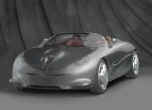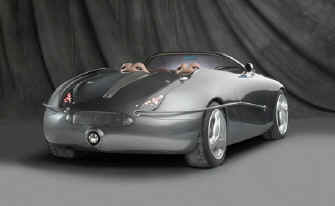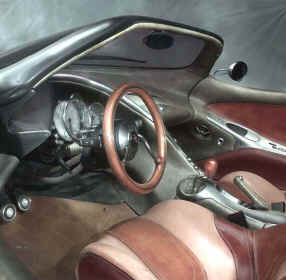Ghia Focus Concept
[Estimated at $100-200,000, Focus brought as astounding $1 million hammer ($1,107,500 with commission) in a spirited exchange between two telephone bidders.]
Christie’s Auction of Unique Design Prototype and Concept Auto Show Models from the Ford Motor Company Collection
Ghia Focus Concept, 1992
Metallic Gunmetal,Brown leather
The 1992 Ghia Focus was designed by Taru Lahti and is an intricate, eclectic, iconoclastic, imaginative example of automotive sculpture. Ghia Focus is a constantly fascinating symphony of shapes, textures, materials and forms, subtly formed and juxtaposed in both expected and unconventional ways. It abounds in details, but its details harmonize with its overall form and substance. They’re never jarring or uncomfortable. They’re always pleasing.

J Mays, Ford’s vice president of Design, describes Ghia’s Focus as, “A concept that is as close to a piece of art as you’ll ever find, an astounding one-off that has less to do with auto design than [with] sculpture.” Mays recalled being captivated by Ghia Focus when he saw it for the first time at its 1992 Turin Show debut.
Camilo Pardo, now Chief Designer at Ford’s Living Legends studio in Dearborn, worked with Taru Lahti at Ghia while Focus took shape. Pardo points to the organic textures, materials and shapes that float, like the amoeba they sometimes resemble, throughout the realization of Ghia Focus as a breakthrough in auto concepts.
Ghia Focus is built on a 100mm shortened floorpan from the full time 4 wheel drive Escort RS Cosworth with the Cosworth’s 227 horsepower turbocharged and intercooled 16-valve 4-cylinder engine. The body is constructed from carbon fiber composite. Curb weight is 2,100 pounds. Ghia Focus sits on 18″ split rim alloy wheels behind full plastic wheel covers mounting 225/45 front – 255/40ZR-18 rear Goodyear tires with a custom cut tread pattern that complements Ghia Focus’s design. Ghia Focus is a roadster, with a removable hardtop that stows under a hatch in the rear deck. It is designed also to have a folding soft top. Those are the technical details, but as J Mays noted, Ghia Focus is more about sculpture than it is about automobiles.
Taru Lahti’s sculpture started with the nose, rounded in plan view with a Mustang-like hood scoop. Small projector headlights and marker lights reside behind clear plastic covers. The air intake for the radiator, intercooler and engine is under the nose. The corners of the nose are marked by horizontal canard fins.
Just in front of the steeply sloping curved windscreen at the back corners of the a series of small irregularly-placed holes which foreshadow the unique taillights. The sides of Ghia Focus are slightly indented and protected by one of its novel features, a round side protection bar that emerges from the front of the door, parallels the profile of the sides rising slightly to the rear where it intersects the top of the rear wheelwell and around the quarter to terminate at the license plate housing.
 The tops of the rear fenders peak above the wheels for occupants’ rollover protection, curving inward to wrap slightly over the rear deck, creating a channel shaped like sand blown around a stone. The tail and marker lights are an array of small irregularly-placed round lights that seem to dribble across the rear deck’s corners. The exhaust is a single outlet below the license plate enclosure, a SuperTrap silencer poking through the gunmetal-painted carbon fiber.
The tops of the rear fenders peak above the wheels for occupants’ rollover protection, curving inward to wrap slightly over the rear deck, creating a channel shaped like sand blown around a stone. The tail and marker lights are an array of small irregularly-placed round lights that seem to dribble across the rear deck’s corners. The exhaust is a single outlet below the license plate enclosure, a SuperTrap silencer poking through the gunmetal-painted carbon fiber.
The cockpit floor is covered with curved, formed wood. The seats and door panels are covered in thick natural saddle cowhide in Brown and Tan. The steering wheel has two asymmetrically curved round steel rod spokes at 4 and 8 o’clock supporting a thick laminated wood rim. Asymmetrically-graduated analog instruments are attached to the exposed steering column, their wires enclosed in wound wire sleeves. The same sleeves also house the exterior mirrors’ exposed adjustment cables. Door armrests flow into the tapered edges of a bifurcated binnacle around the steering column which fades into the dash top, then picks up again to flow down through the center stack through the console and up onto the rear deck. The shift lever is formed of two sinuous metal rods, like old grape vines, supporting an asymmetrical wooden shift lever that fits the hand like a well-used sailmaker’s palm. The instruments, outside mirrors, console and rear deck trim are hand-formed, brushed and clear coated steel still showing evidence of the Ghia metal artists’ hammers.
Words do not come close to doing Taru Lahti’s Ghia Focus justice. It is a visual and tactile delight on the order of the most sensuous creations of Jean Bugatti, Joseph Figoni and Franco Scaglione. It is a science fiction fantasy that exudes life.
Ghia’s Focus is “elegant” in the most sincere and innovative way, waiting to grace the lawn at Pebble Beach or Bagatelle.
Click here to return to the Ford Concept index.